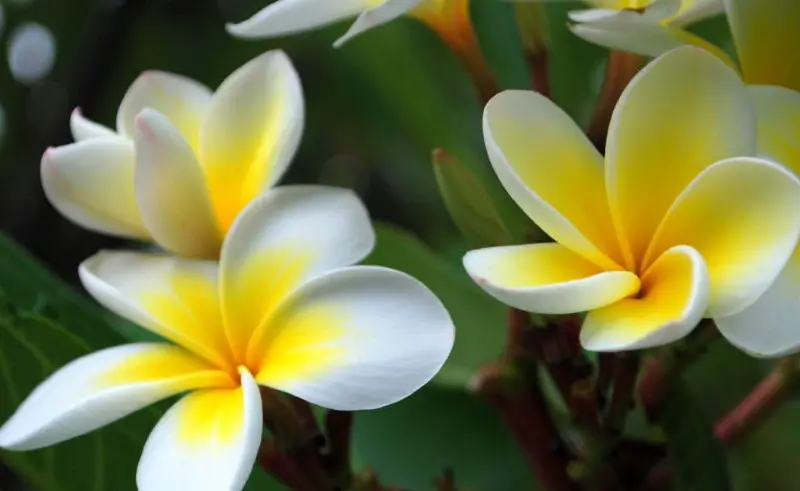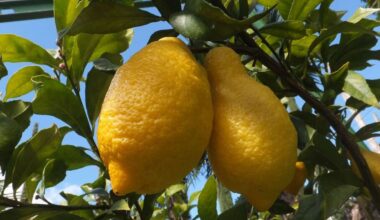Originally from tropical and subtropical America, Plumerias are nowadays found in all hot countries. Obviously, it is a frosty plant which will not support that the thermometer goes below 41°F. Ideally, the temperature should be at least 50 to 54°F.
Depending on the species, these are deciduous or semi-deciduous trees and shrubs. Branches and twigs are fleshy and thick. The simple leaves, alternating or forming a spiral, are grouped at the end of the branches.
Contents
Soil and exposure to plant a Plumeria
The Plumeria is planted in a mixture of soil, fine sand and topsoil, if you put it in a container. Otherwise, it should be in well-drained and fairly rich soil. In any case, it must be in full light or sunshine.
Planting the Plumeria
Indoors, the cultivation of Plumeria in pots requires a relatively rich soil and therefore a good potting soil.
Plumeria needs sunshine. A veranda or winter garden is perfect to install it. If you adopt it at home, place it in front of a bay window.
When to plant the Plumeria
- Indoors, all year round.
- Outdoors, in May.
Plumeria outdoors
This plant is native to Central America and therefore will not adapt to any climate.
- The temperature should never fall below 5°. The rusticity of the frangipane is therefore quite low.
- Favour a well-drained soil to avoid water stagnation.
- You can mix potting soil with river sand (80-20%) and put clay balls at the bottom of the pot to improve drainage.
On the other hand, a potted frangipane can easily spend all summer outdoors.
Repotting of the Plumeria
To bloom and reflower, the Plumeria needs a relatively rich soil.
Pot cultivation requires regular repotting, firstly to give the roots room to develop, and secondly to give it the nutrients it needs.
- Repotting the Plumeria every 2 to 3 years is recommended.
- Choose a pot with a slightly larger diameter.
Maintenance of the Plumeria
Surface with compost in March, then at the end of June. Once a year, bring a natural seaweed-based fertilizer in May.
Remove faded flowers as you go along to stimulate the appearance of new flowers.
Watering the Plumeria
Watering is the most important task to follow, because in order to obtain flowers, it is essential to mark the seasons:
- When the leaves fall in November, the Plumeria goes into dormancy: place it in a cooler room, between 50 and 59°F, until March, and almost stop watering. Once a month is sufficient.
- Starting in March, when the days get longer openly, resume regular watering until fall. The soil should dry 0.5 inches on the surface between waterings. Always water with non-calcareous water.
Where to plant the Plumeria
Indoors, place the Plumeria in a largely sunny place for a good part of the day. It is possible to take it out in the garden from May to September while avoiding it to burn in the sun. In addition, a sudden change can stress the plant.
Pruning the Plumeria
The Plumeria doesn’t need any size, but as it tolerates it well, don’t hesitate if you have to keep it under control, if it becomes a nuisance for the passage for example, or to densify it, March-April is the best period to operate!
But don’t do it every year, otherwise you will never see the flowers that form at the end of the branches.
If you plan to prune your Plumeria, do it on one half, so as not to deprive yourself of flowering, and continue the second year on the other half.
For a better branching, cut the branches by half or a third.
Plumeria diseases
If you see a white cottony mass, it is undoubtedly the mealy bug.
This parasite settles when the room atmosphere is too dry and the temperature is high.
It is also possible that the Plumeria will rot when the soil is too wet.
Only water when the soil is dry and make sure that your pot does not let water stagnate near the roots, it must be well drained and perforated at the bottom.
Summary
The Plumeria is a shrub known for its magnificent porcelain flowers with a bewitching perfume. It is besides one of the most powerful perfumes in the plant world. This plant native to tropical and subtropical America is of course frosty and does not tolerate temperatures below 41°F.









